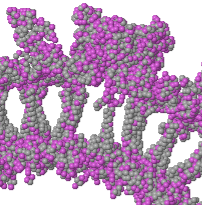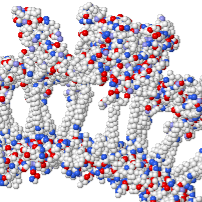Virus capsids and similarly large protein assemblies can be conveniently visualized and analyzed with FirstGlance in Jmol. Below some examples are explained and illustrated, but here is a quick start: polio virus capsid in FirstGlance (1pov).
FirstGlance in Jmol automatically constructs biological unit 1, thought to be the major functional quaternary assembly. Biological unit 1 is shown initially by default, and you can start separate sessions to show the asymmetric unit or other biological units when more than one are specified. When the resulting assembly is too large to work smoothly and efficiently in FirstGlance in Jmol (all Javascript), FirstGlance will automatically simplify the model to alpha carbons, or when necessary, to a subset of alpha carbons.
Most of the scenes below use color schemes that are built into FirstGlance, and are displayed very easily with just a few clicks of the mouse. The evolutionary conservation color scheme requires that the model be pre-processed by the ConSurf Server. It produces a PDB file understood by FirstGlance, which will automatically color the model by evolutionary conservation in its initial view.
Polio Virus
Click the green links below to change the molecular scene.
Rotate to view the molecule from all sides (drag to rotate).
Zoom with your mouse wheel, or Shift-Drag up/down.
|
The polio (poliomyelitis) virus mostly infects children under 5, and 1/200 infections causes permanent paralysis with 5-10% of those being fatal[1]. Vaccines were developed in the 1950s[2]. Polio is nearly eradicated worldwide, but endemic pockets persist in regions of Afghanistan and Pakistan where vaccination campaigns are most challenging[3][1]. Polio was declared eradicated from the Americas in 1994, but in 2022 a live vaccine-derived strain of polio was found circulating in parts of New York State, USA[4]. Polio vaccination is urged for all children, and for unvaccinated adults[5].
Polio virus is small (among viruses pathogenic for humans) with an RNA genome inside a single-shell protein capsid. 1pov made up from 3 proteins, 60 copies of each of VP0, VP1 and VP3 (from proteolysis of polyprotein UniProt P03300)[6]. 1pov provides the structure of the 3 chains in the asymmetric unit, along with instructions for constructing the capsid (Biological Unit 1)[7].
The polio capsid has an icosahedral construction with 12 vertices defining 20 triangular faces. Notice that the larger blue mesas protruding on the surface have 5-fold symmetry. These are pentagonal capsomeres at the 12 vertices. The capsid is composed of 180 protein chains totaling about 377K non-H atoms. The molecular mass of this capsid structure is 5.9 MDa.
Quick Start: polio virus capsid 1pov in FirstGlance
Measuring Capsid Diameter
FirstGlance/How To Measure A Virus Capsid provides step by step instructions on how to view a slab of the capsid and measure distances.
Color Schemes
(see caption). In addition to coloring by distance from the center, or assigning a distinct color to each group of sequence-identical chains, FirstGlance offers coloring by amino to carboxy rainbow, hydrophobic vs. polar, charge, and as illustrated below, evolutionary conservation.
Hide and Isolate
Hide and Isolate tools are provided in the Focus Box of FirstGlance. Clicking on a chain offers to hide or isolate all sequence-identical chains. Here,
(shown as a half-capsid).
Similarly one can easily isolate
or
Polio Resources
Eastern Equine Encephalitis Virus
Click the green links below to change the molecular scene.
Rotate to view the molecule from all sides (drag to rotate).
Zoom with your mouse wheel, or Shift-Drag up/down.
|
Human Eastern Equine Encephalitis is rare, with only a few cases reported in the USA each year. However, 30% of patients die, and there is no vaccine for humans and no specific medication. Many survivors have ongoing neurologic problems. The virus is spread by the bites of mosquitos that fed on infected animals.[8][9]
Eastern Equine Encephalitis Virus is an alphavirus with a single-stranded RNA genome enclosed in an icosahedral protein capsid that includes a lipid bilayer envelope[10]. The (EEEV) consists of 240 copies of each of three distinct protein sequences, totaling 720 chains. It has nearly 2 million non-hydrogen atoms (so about 3.8 million atoms including hydrogen). The structure 6mx4 determined by electron microscopy (4.4 Å resolution) has 12 chains, with instructions for constructing the entire capsid using 60 copies of the asymmetric unit[14].
Quick Start: EEEV capsid 6mx4 in FirstGlance -- To cut away half of the capsid, depress the Slab button (in the Views tab). Then check both "Don't hide the back" and "Rotate slab".
Double-Shelled Capsid
Immediately you can see that this is a double-layered capsid, with outer and inner shells. Between the shells are transmembrane alpha helical "spikes" or "posts" embedded in a lipid bilayer (not represented by any atoms here).
FirstGlance/How To Measure A Virus Capsid provides step by step instructions on how to view a slab of the capsid and measure distances.
The inside diameter is about 315 Å. The length of the transmembrane spikes/posts is about 35 Å, consistent with the thickness of a lipid bilayer.
(total 720 protein chains).
Transmembrane Posts
When all ~242K alpha carbons (rather than every 10th) are displayed in FirstGlance, performance is sluggish,
but more color schemes can be meaningfully applied.
Coloring alpha carbons in a slab by Hydrophobic, Polar reveals that the transmembrane posts are largely hydrophobic.
So, as expected, coloring the slab alpha carbons by charge
Anionic (-) / Cationic (+)
shows the posts to be nearly devoid of charges.
Clathrin Coat
This (3iyv), determined by electron microscopy at 7.9 Å resolution[11], represents the clathrin lattice structure enveloping coated pits and coated vesicles. The deposited model contains only alpha carbons. It is about 725 by 665 Å. There are 184K alpha carbons, so it would have about three million atoms including hydrogens, with a molecular mass of about 21 MDa. 96% of the model is composed of 108 clathrin heavy chains, each of which models 1,630 of the 1,675 residues in UniProt P49951. , each modeled as 70 of 243 residues of UniProt P04973.
Quick Start: Clathrin Coat 3iyv in FirstGlance
Amino and Carboxy Termini
with its amino terminus blue and carboxy terminus red (with a spectal rainbow color sequence in between). When , it becomes evident that the carboxy termini are on the outside surface, while the amino termini form the inner surface.
Secondary Structure
Alpha Helices, Beta Strands , Loops
is nearly all beta sheets and loops, arranged as seven antiparallel 4-beta-strand sheets in a donut, forming a compact domain of 330 amino acids about 45 Å in diameter. The remaining 1,300 amino acids of the heavy chain form a "snake" about 460 Å long and roughly 20 Å thick. It is nearly all antiparallel alpha helices orthogonal to the long dimension. The 70 residues of the light chain present were modeled as helical. When the entire clathrin coat model is colored by secondary structure (NOT SHOWN), the outside surface is made of the alpha-helical "snakes", and the inner surface is lined with the amino-terminal beta-sheet donuts.
Vault Nanocompartment
occurs in eukaryotes.
It is about 650 Å long and 380 Å wide.
Its function is unknown[12]. The vault is composed of 78 copies of a single protein sequence.
This model has nearly one million atoms (including hydrogens), and 61K alpha carbons.
Quick Start: Vault 6bp8 in FirstGlance
Evolutionary Conservation

Quick Start: Vault with Conservation in FirstGlance (all 61K alpha carbons)
Conservation analysis was performed by ConSurf. In order for the pattern to be meaningful, all 61K alpha carbons were loaded into FirstGlance, which then applied the conservation colors.
Secondary Structure
amino-terminal portion consists of
a series of small antiparallel beta sheet domains. A long alpha helix forms the carboxy-terminal portion.
Alpha Helices, Beta Strands , Loops
Take a closer look at the or the .
Here is the
Bacterial Gas Vesicle
Click the green links below to change the molecular scene.
Rotate to view the molecule from all sides (drag to rotate).
Zoom with your mouse wheel, or Shift-Drag up/down.
|
"Gas vesicles allow a diverse group of bacteria and archaea to move in the water column by controlling their buoyancy. These gas-filled cellular nanocompartments are formed by up to micrometers long protein shells that are permeable only to gas."[13] (7r1c). The actual nanocompartments are much longer, and taper down to conical caps at the ends.[13] Actual gas vesicles vary in diameter, with some being about twice the diameter of this model.[13] This model has 930 copies of a single protein sequence of 88 amino acids (GVpA, UniProt A0A0B6AAV2). It is 9 MDa with about 900K atoms including hydrogen and 60,450 alpha carbons. Actual gas vesicles can approach 1 μm in length with masses of hundreds of MDa[13].
Quick Start: Gas Vesicle 7r1c in FirstGlance
Hydrophobic Inner Surface
The hydrophobic inside is thought to prevent the vesicle from filling with water (liquid or vapor).[13]
Evolutionary Conservation
Evolutionary conservation of the amino acids in GVpA was determined by the ConSurf Server.

Quick Start: Evolutionary conservation of the gas vesicle in FirstGlance.
Possibly those conserved are involved in binding a stabilizing protein absent from this model, GVpC[13]. Amino acids lining the inside surface are generally conserved, probably related to the ability of the vesicle to acquire gas selectively.









